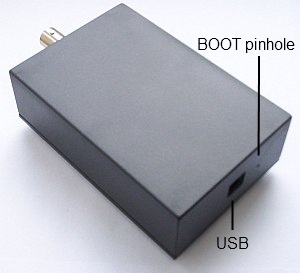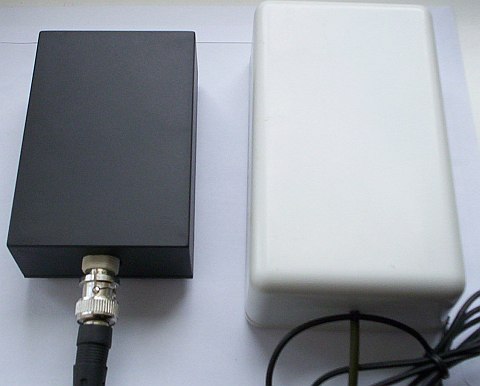Miniscope v2b
Miniscope v2b is a low cost PC/USB miniature oscilloscope/analog signal recorder based on AT91SAM7S64 microcontroller. This is a direct successor of miniscope v2/v2a. Specification:
- single channel (as with miniscope v2/v2a adding extra channels at a cost of sampling frequency should not be a problem),
- sampling: 500 kSps, 8 bit, real-time data streaming to PC via USB full-speed,
- firmware based on CDC example (WinARM) but using libusb-win32 as a device driver,
- does not require programmer - using SAM-BA USB bootloader from ROM,
- analog front-end:
- 4 gain ranges, measuring voltage up to +/- 16.5V,
- standard input resistance (1 MOhm), compatible with standard oscilloscope probes keeping their nominal ratio,
- AC/DC switch,
- MAX232 (or similar) used as very cheap capacitance voltage doubler and inverter powering analog front-end,
- bandwidth (-3 dB) measured with TL082, C8 = 0, R16 = 1k, inverter gain = 3: 66 kHz,
- PC GUI: miniscope v4 (windows only) interfaced via provided dll library,
- large sample buffer sizes and very large (up to 1 giga sample) continuous signal recording capability - limited only by PC and data storage format.
Scheme: miniscope_v2b_20110623.pdf
Eagle files: miniscope_v2b_20110623.zip
BOM
Firmware: armscope_v2b_dma_20110623.zip
Device library for miniscope v4, sources are shared with miniscope v2a: armscope_dma_1ch_dll_0_1_5.7z. Changes since version 0.1.4 (miniscope v2a):
- added DEVICE_ARMSCOPE_V2_DMA / DEVICE_ARMSCOPE_V2b_DMA switch,
- updated interface to v12 (see miniscope v4 for details),
- added larger buffer sizes (up to 512 k samples) to capabilities,
- libusb-win32 updated to 1.2.4,
- reading data from device uses now asynchronous libusb API (should minimize risk of data loss and data discontinuity).
2012.10.06 Thanks to Openmoko assigning USB PIDs to open
source projects miniscope v2b has got it's own unique
VID = 0x1d50, PID = 0x604e pair.
Update firmware, driver files and dll for miniscope v4:
armscope_v2b_dma_20121006.zip
armscope_dma_1ch_dll_0_1_6.7z
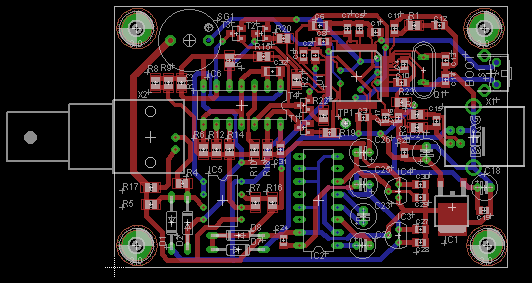
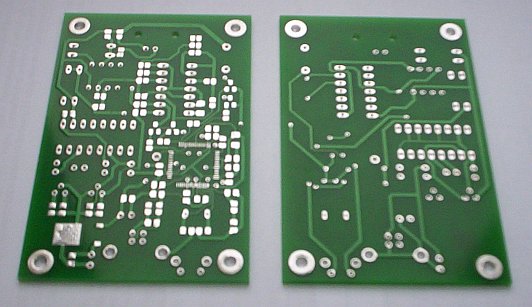
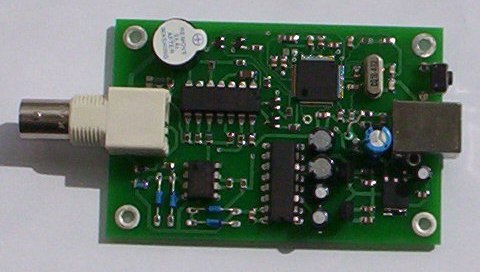
Remarks:
- insulating spacer should be placer under crystal resonator to prevent metal resonator package from touching pad/trace; if you can't find one at local shop use i.e. piece of paper reel from 0805 SMD component,
- C8 was intended to limit bandwidth and reduce noises; actual noises are nearly negligible even without this capacitor (2 bits p-p or less at highest sampling frequency); few hundreds pF up to 2.2 nF maybe seems reasonable when limiting bandwidth,
- R8 and R9 in parallel are intended to shifting 0 V (GND) level; I've used 1 MOhm as R9 making measure range a little bit asymmetric (in general you will be measuring positive voltage more often than negative, so few more bits on positive side than on negative side are not a problem),
- same as with v2/v2a version gain and offset can (or should) be software-calibrated for each range thus no precise resistance matching for amplifier is necessary,
- '4066 should be from CMOS 4000 or HC series (not HCT!),
- I've used standard Eagle decal for BNC socket and it has no pads at two thick mounting pins (is this for other type of package?) - socket can still be firmly secured with a drop of solder on those pins, but regular pads would look nicer,
- TP1 ("test point") has no purpose right now; firmware is very simple and should not require any debugging - on the other hand buzzer is quite useful as it generates acoustic feedback when connecting USB and changing gain or AC/DC mode,
- BNC connector adds some professional look for sure, buf if don't have any oscilloscope probe and don't want to buy one (even entry-level probes can be almost as expensive as this oscilloscope) than RCA might be more convenient.
- when I was assembling another unit in 2019 neither SAM-BA 2.18 nor BOSSA worked for me when I was trying to program SAM7S64 under windows 7 x64; BOSSA on 64-bit linux worked, I had to run it with superuser priviledges though
- to install libusb-win32 driver on any newer and/or 64-bit OS use Zadig tool
PCB fits well inside KM-4 enclosure (90x60x27 mm).
It is fastened with four M3 screws and distance bushes that also hold rubber feets.
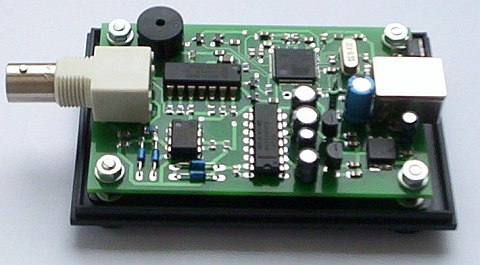
It is much smaller than enclosure used with older v2 although it seems less sturdy.
